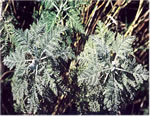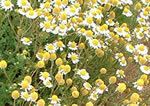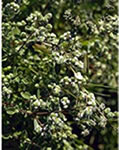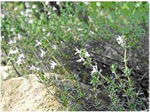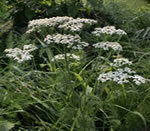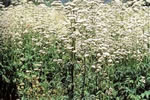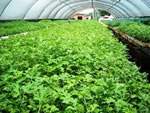BioAfrica's Plant Profile Selection
BioAfrica is responsible for the Planting and Growing of a wide variety of different Herbs and Medicinal Plants. Of the hundreds to choose from, we have selected a handful of herbs to showcase that are ideally suited to southern african growing conditions, as well as being highly lucrative for farmers to grow.
Click on a herb image or name for a more in depth and detailed profile.
Artemisia Afra
Artemisia afra is a highly aromatic plant known as 'wildeals' (Afrikaans); umhlonyane (Xhosa); umhlonyane (Zulu); lengana (Sotho). It an erect multi-stemmed perennial shrub of up to two metres in height and is widely distributed in Southern Africa. Lengana is one of the most widely used traditional medicines in Southern Africa. Numerous ailments are treated with it, mainly coughs, colds and influenza but also fever, loss of appetite, colic, headache, earache, malaria fever and intestinal worms etc.
Chamomile
There are 4 different types of chamomile plants for essential oils. The two commonly used are the German and Roman chamomile. The two lesser know are the Maroc and Cape chamomile. Chamomile is used in a variety of ways, such as an analgesic, anti inflammatory, antispasmodic, calmative, migraine control, helps menopause. Chamomile extracts can also be used as a pesticide.
Marjoram
Marjoram is a favourite for many farmers and is a special showcase herb as it is only planted once every seven years, providing additional profits to the grower due to the reduced planting costs.
It is highly fragrant and calming herb that has a mild anti oxidant, anti fungal and anti-spasmodic properties. The dried leaves of sweet marjoram are widely used by food industry as flavouring agents for dressing, soups, and in formulation of vermouth and bitters.The (volatile) extract is known for its antibacterial, anti fungal, and antioxidant properties.
Thyme
Thyme is a semi-woody sub shrub with aromatic, linear to oval, slightly tomentose (fuzzy), gray-green leaves that are about a half inch long. Medicinally, thyme has been used to treat depression, nightmares, leprosy, paralysis, and excessive infestations of body lice. More currently, the thyme oil derivative thymol has been used as an antiseptic on World War II battlefields and today in toothpastes and mouthwashes. Thyme is said to aid digestion, especially of fats. This may explain its wide use in stews, soups, meat, fish, and egg dishes, either on its own, as part of a bouquet garni, or in combination with parsley, sage, and rosemary.
Yarrow
Yarrow grows from 10 to 20 inches high, a single stem, fibrous and rough, the leaves alternate, 3 to 4 inches long and 1 inch broad, larger and rosette at the base, clasping the stem, bipinnatifid, the segments very finely cut, fern-like, dark-green, giving the leaves a feathery appearance. Yarrow is a very valuable medicinal herb, with much scientific evidence of use in alternative medicine as an antiseptic, antispasmodic, astringent, carminative, diaphoretic, digestive, emmenagogue, stimulant, and tonics, vasodilator and vulnerary. Yarrow is used against colds, cramps, fevers, kidney disorders, toothaches, skin irritations, and hemorrhages, and to regulate menses, stimulate the flow of bile, and purify the blood. Medicinal tea is a good remedy for severe colds and flu, for stomach ulcers, amenorrhea, abdominal cramps, abscesses, trauma and bleeding, and to reduce inflammation.
Valerian
Valerian grows from a short rhizome to 2 m high, flowers, and then dies. It grows from Spring till the next Autumn. Valerian has pinnately-divided leaves with six to 10 pairs of lance-shaped leaflets, and bears small white or pink fragrant flowers. These heads bear small (5 mm) tapered seeds that are spread by wind. The fresh root has the appearance of a mass of long, white, relatively tangled roots, up to 5 mm in diameter and 30 cm long, with a very distinctive and strong penetrating odour. Valerian extracts and the essential oil are used in flavouring components in most major food product groups including alcoholic and nonalcoholic beverages, meat and meat products, frozen dairy desserts, sweets and baked goods.
Geranium
There are over 700 varieties of cultivated geranium; however, most are grown for ornamental purposes only. The oil producing species are P. graveolens, P. radens and P. capitatum. Pelargoniums are native to South Africa, and the Sotho used a paste made from the leaves to treat wounds and abscesses. The well-known geranium oil "Bourbon" is produced from the cultivars Rose, which is a hybrid of P. radens and P. capitatum.

 Proud to be
Proud to be